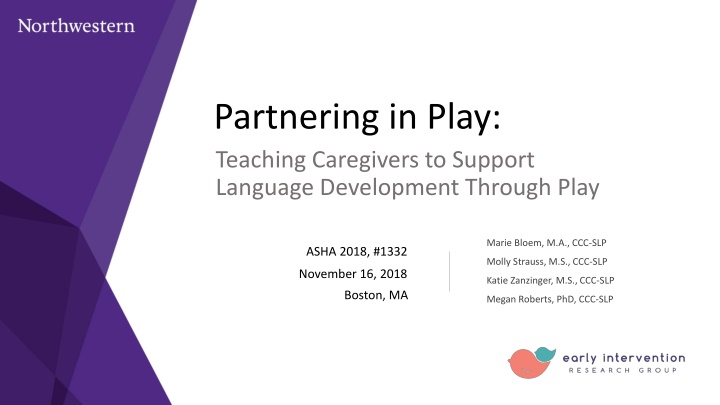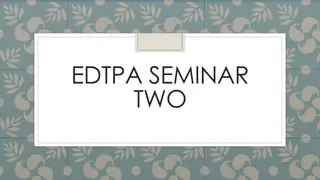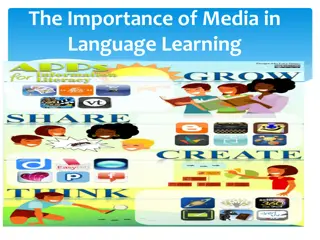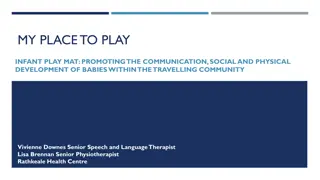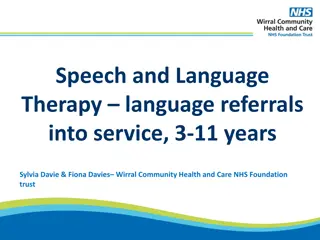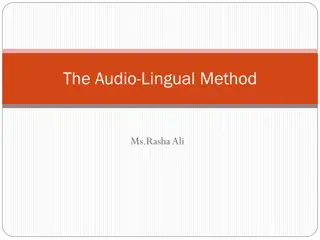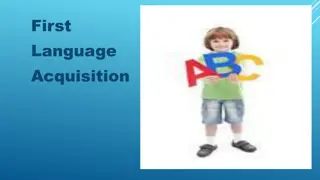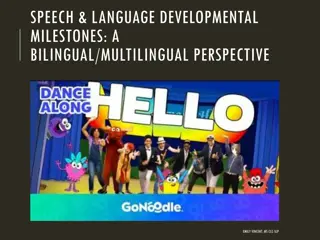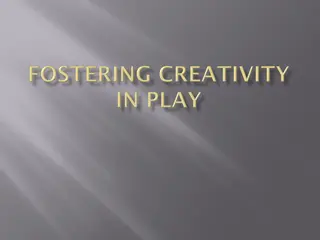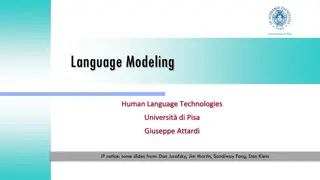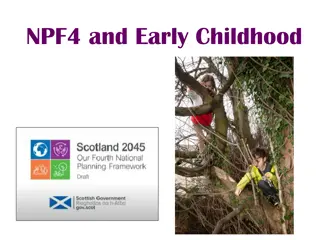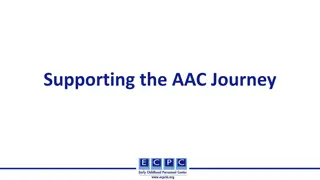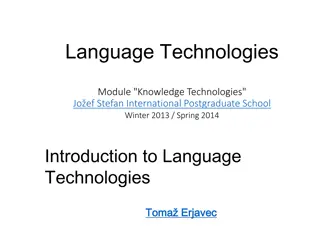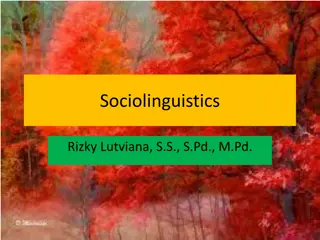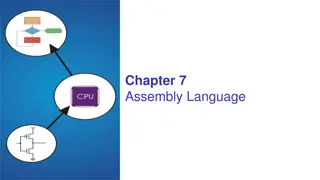Supporting Language Development Through Play
Partnering in Play: Teaching caregivers to support language development through play. Explore the framework, skills, expertise, and effectiveness of involving caregivers in enhancing children's language abilities. Research-backed strategies for effective service delivery model are highlighted.
Download Presentation

Please find below an Image/Link to download the presentation.
The content on the website is provided AS IS for your information and personal use only. It may not be sold, licensed, or shared on other websites without obtaining consent from the author.If you encounter any issues during the download, it is possible that the publisher has removed the file from their server.
You are allowed to download the files provided on this website for personal or commercial use, subject to the condition that they are used lawfully. All files are the property of their respective owners.
The content on the website is provided AS IS for your information and personal use only. It may not be sold, licensed, or shared on other websites without obtaining consent from the author.
E N D
Presentation Transcript
Partnering in Play: Teaching Caregivers to Support Language Development Through Play Marie Bloem, M.A., CCC-SLP ASHA 2018, #1332 Molly Strauss, M.S., CCC-SLP November 16, 2018 Katie Zanzinger, M.S., CCC-SLP Boston, MA Megan Roberts, PhD, CCC-SLP
DISCLOSURES: FINANCIAL: Ms. Bloem, Ms. Roberts, Ms. Strauss, and Ms. Zanzinger are employees of and receive salary from Northwestern University. They are members of the Early Intervention Research Group, which receives research grants from the National Institutes of Health and from the Institute of Education Sciences. NON-FINANCIAL: No relevant nonfinancial relationship exists. PERMISSIONS: Parents have all given written permission to share their videos for training purposes. You are not permitted to photograph or record the presentation. 2
1 FRAMEWORK 2 PLAY LEVELS 3 STRATEGIES 4 COACHING 5 CLOSING / Q & A OUTLINE
> > WHY PLAY WHY CAREGIVERS 1 FRAMEWORK
FRAMEWORK SKILLS Play helps build a variety of skills Language12, 23 Motor20 Cognitive15, 21 Social-Emotional1 > WHY PLAY WHY CAREGIVERS NATURAL CONTEXT Play is a natural context in which children frequently engage with their caregivers. 6
FRAMEWORK EXPERTISE Parents provide critical expertise to the team. EMPOWERMENT WHY PLAY WHY CAREGIVERS Involvement increases capacity for self-reflection and self-evaluation18 > EFFECTIVENESS Research demonstrates that training caregivers is the most effective service-delivery model. Dosage Caregiver language impact 8, 21, 24 Efficacy trials and comparison analyses 16, 17, 18 7
FRAMEWORK 17 RCT Efficacy Trial: Do Parent-Implemented Interventions Work? Intervention (45 children) 2 sessions/week 3 months Receptive Lang: Improvements in all areas Expressive Lang: Increased NDW Caregivers reported using the strategies on average 17 hours per week. Caregivers did not report additional stress 97 children Control (52 children) Care as usual Roberts, M. Y., & Kaiser, A. P. (2015). Early intervention for toddlers with language delays: a randomized controlled trial. Pediatrics, 135(4), 686-693. 8 8
FRAMEWORK 18 Meta-Analysis: Do Parent-Implemented Interventions Work Better? Results: Population: Studies Included: Interventions had significant, positive impact on receptive and expressive language abilities 18-60 months 18 studies met pre-determined criteria Interventions lasted 10-13 weeks Primary or secondary language impairments Interventions had <26 hours of parent training Roberts, M.Y. & Kaiser, A.P. (2011). The effectiveness of parent-implemented language interventions: A meta-analysis. American Journal of Speech-Language Pathology, 20(3), 180-199. 9 9
FRAMEWORK 18 Meta-Analysis: Do Parent-Implemented Interventions Work Better? significant Roberts, M.Y. & Kaiser, A.P. (2011). The effectiveness of parent-implemented language interventions: A meta-analysis. American Journal of Speech-Language Pathology, 20(3), 180-199. 10
> > > HIERARCHY ASSESSMENT GOALS 2 PLAY LEVELS
PLAY LEVELS SIMPLE COMBINATION PRE-SYMBOLIC SYMBOLIC 1 > HIERARCHY ASSESSMENT GOALS 2 3 4 12
PLAY LEVELS: HIERARCHY 6 - 12 months 1 SIMPLE COMBINATION PRE-SYMBOLIC SYMBOLIC Sensory exploration, cause and effect manipulating a single object at a time 13
PLAY LEVELS: HIERARCHY VIDEO 14 14
PLAY LEVELS: HIERARCHY 12 months SIMPLE COMBINATION PRE-SYMBOLIC SYMBOLIC Simple manipulation and using multiple objects at a time 2 General combination Fitted combination Associated combinations Toy specific combinations 15
PLAY LEVELS: HIERARCHY VIDEO 16 16
PLAY LEVELS: HIERARCHY 12 18 months SIMPLE COMBINATION PRE-SYMBOLIC SYMBOLIC Pretending to use objects for their intended purpose Self-directed Directed towards others 3 17
PLAY LEVELS: HIERARCHY VIDEO 18 18
PLAY LEVELS: HIERARCHY 15 24 months Separate knowledge of an object from its representation, and sequence multiple actions into coherent play scheme SIMPLE COMBINATION PRE-SYMBOLIC SYMBOLIC 4 Substitution Imaginary 19
PLAY LEVELS: HIERARCHY VIDEO 20 20
PLAY LEVELS PURPOSE MATERIALS ADMINISTRATION SCORING 1 HIERARCHY ASSESSMENT GOALS 2 > 3 4 21
PLAY LEVELS: ASSESSMENT Provides critical information about a child s play 1 PURPOSE MATERIALS ADMINISTRATION SCORING Unsupported play level Diversity of play Frequency of play acts Strengths and weaknesses Play preferences 22
PLAY LEVELS: ASSESSMENT PURPOSE MATERIALS ADMINISTRATION SCORING 2 23
PLAY LEVELS: ASSESSMENT PURPOSE MATERIALS ADMINISTRATION SCORING Observe Prompt Model 3 24
PLAY LEVELS: ASSESSMENT Play Level Examples Observed Prompted Modeled Squeezes dolls, stands up the bottle n/a n/a Early Play PURPOSE MATERIALS ADMINISTRATION Takes lid on or off the teapot, puts sponge in the cup Combination / Relational Play n/a n/a Pretends to eat off of the spoon, feeds baby with the spoon Pre-symbolic / Functional Play X X 4 SCORING Uses sponge as food, feeds dolls, wipes it s face, and then puts it to bed Symbolic / Pretend Play X X X 25
PLAY LEVELS HIERARCHY ASSESSMENT GOALS LEVELS PLANNING 1 2 > 26
PLAY LEVELS: GOALS CURRENT LEVEL The most frequent spontaneous act across sets reveals the level the child is most comfortable playing. LEVELS PLANNING 1 NEXT LEVEL Higher levels that are demonstrated infrequently, occur with only one toy set, or appear only when given support suggest emerging skills 27
PLAY LEVELS: GOALS GOAL: To have the child complete the target level of play without support LEVELS PLANNING 2 INTERVENTION PLAN: Join the child at their preferred play level and scaffold higher-level skills 28
1 FOLLOW CHILD S LEAD ARRANGE ENVIRONMENT MIRROR AND MAP BUILD PREDICTABLE STEPS EXPAND PLAY 2 3 INTERVENTION STRATEGIES 3 4 5
INTERVENTION STRATEGIES HOW: Follow child s ideas and preferences Be flexible in how you play with toys Notice child s behavior Avoid questions Avoid directions 1 FOLLOW THE CHILD S LEAD WHY: This creates responsive interactions that align with how children learn at this early age Following the child s lead naturally reinforces and encourages the child s play and communication 30
INTERVENTION STRATEGIES VIDEO 31
INTERVENTION STRATEGIES HOW: Get face to face Remove distractions Remove inappropriate toys Assist child with difficult motor play actions Lay out a few appropriate toy options around the room partially set up 2 ARRANGE THE ENVIRONMENT WHY: Arranging the environment sets the stage for a great play interaction It allows the child to lead the play while giving us opportunities to scaffold higher levels 32
INTERVENTION STRATEGIES VIDEO 33
INTERVENTION STRATEGIES HOW: Imitate the child s play act (mirror), and then label the action (action) 3 MIRROR AND MAP WHY: This provides a practical way to join in play with the toys Models commenting in play Promotes receptive language of verbs 34
INTERVENTION STRATEGIES VIDEO 1 VIDEO 2 VIDEO 3 35
INTERVENTION STRATEGIES HOW: Start with the child s preferred actions Find a way to restart and do the same actions again 4 BUILD PREDICTABLE STEPS WHY: Promotes independence in play More likely to engage on their own when they know what to expect Adult uses consistent language models 36
INTERVENTION STRATEGIES VIDEO 37
INTERVENTION STRATEGIES HOW: Slowly increase the complexity and/or diversity of the play 5 EXPAND PLAY Model Hand Set Out WHY: Adding additional actions and toys allows for modeling more diverse vocabulary Helps to maintain engagement and keep the child from getting bored 38
INTERVENTION STRATEGIES VIDEO 1 VIDEO 2 39
Group Activity Brainstorm play routines and expansions for various toy sets What do they do with the toy now? What actions can we add? What other toys could you add? TOY SET 40 40
TEACH MODEL COACH REVIEW 1 2 4 COACHING 3 4
COACHING WHAT IT LOOKS LIKE: Therapist is primarily interacting with the parent including reviewing the strategy and providing relevant examples for activities planned for this session 1 TEACH MODEL COACH REVIEW HOW: Explain the strategy and why we use it Walk through a child-specific example Role-play scenarios for practice 42
INTERVENTION STRATEGIES VIDEO 43
COACHING WHAT IT LOOKS LIKE: Therapist is primarily interacting with the child including demonstrating and highlighting the strategy of the day TEACH MODEL COACH REVIEW 2 HOW: Demonstrate the strategy that was explained during the teach phase Point out and highlight your use of the strategy in real time Don t let your narration interrupt the play or engagement 44
INTERVENTION STRATEGIES VIDEO 45
COACHING WHAT IT LOOKS LIKE: TEACH MODEL COACH REVIEW Parent is primarily interacting with the child while the therapist coaches them on how to set up and use the target strategy of the day. 3 HOW: Shape parent behavior through specific praise and corrective feedback Assist the parent in their play interaction (handing toys, giving ideas, managing behavior) 46
INTERVENTION STRATEGIES VIDEO 47
COACHING WHAT IT LOOKS LIKE: TEACH MODEL COACH REVIEW 4 Therapist is primarily interacting with the parent including reviewing the parent s use of strategies and the impact on the child HOW: Summarize how the parent used the strategy Relate an example of parent s behavior to child s behavior Engage in reflective discussion by using probing questions 48
INTERVENTION STRATEGIES VIDEO 1 VIDEO 2 49
1 PARENT REFLECTIONS PROGRESS VIDEOS COMMON CONCERNS SUMMARY Q & A 2 5 CLOSING 3 4 5
